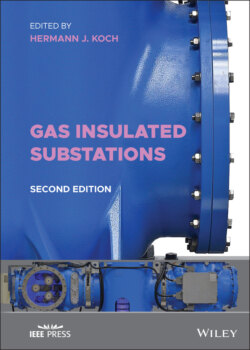Читать книгу Gas Insulated Substations - Группа авторов - Страница 10
Foreword of Editor
ОглавлениеSince the first publication of the Gas‐Insulated Substations (GIS) book in 2014, the technical development of new solutions and types of applications has increased. The second edition of the GIS book updates the complete text to cover recent technical developments and applications. New chapters have been added on new topics for the use of GIS.
IEEE PES Substations Committee Working Group K10 was charged with the revision work. Many experts from the industry, users, manufacturers and consultants contributed their knowledge and information on the technical changes in gas‐insulated high‐voltage technology of 52 kV and above.
There are significant changes to GIS technology related to insulating gases, substation resilience, high voltage vacuum switching technology, low power instrument transformers with electronic sensors, digital twin concepts, application of GIS for offshore windfarms and energy collecting platforms, and the operating requirements of digital substations using GIS. These topics are covered by new chapters added to the GIS book.
GIS also plays an increasing role in the development of higher resilience of the electric power network and to provide lower risk of power delivery interruption during extreme weather and climate conditions. GIS can also contribute to faster re‐energization of a substation after disasters have caused power delivery interruption. Indoor and even underground substations using GIS technology are one method to increase the resilience of the energy networks. The other method of mobile GIS provides ready to connect high voltage substations assembled on trucks and trailers, which can be energized within a short period of time to replace a damaged substation. These mobile GIS concepts are available for voltages up to 500 kV.
There are many practical examples of GIS installations world‐wide that provide examples of successful project in operation. These examples have been extended by case studies for city and network developments to show new possibilities with using GIS in the substation. Underground substations in metropolitan areas and city centers offer technical options to bring electric power to city or industry developments, when only little space and right of way is available. Underground projects are presented from all over the world to show new GIS‐related options. With case studies on city development projects, the complex situation to apply power infrastructure is shown and options are explained when using GIS.
Special buildings is a chapter which describes the combination of high‐voltage electric power supply installations within the same buildings as offices, apartments, restaurants, public places like cinemas, theaters, or spaces for sports events. The combination of multiple uses of buildings and power supply infrastructure makes GIS a perfect technology to provide the functions of high‐power switching capabilities in a small space, such as in the basement of buildings. Examples from all over the world are presented in this chapter including the economic comparison with other technical solutions like classical air‐insulated substations. Those cases are explained and the result provides the most efficient and economical solution.
Advanced Technology is dedicated to GIS developments in new technologies and applications. This covers applications of high voltage vacuum circuit breakers of 145 kV up to 500 kV to allow GIS using only technical air and vacuum with no contributing gas to global warming potential.
DC GIS is seen as a new implementation to high voltage direct current (HV DC) transmission systems and provide substantial space and foot print reductions for the converter and transition stations.
Digital substations are key element of the future intelligent or smart electric power network for optimized management and safe control.Soft technical topics like environmental acceptance, life cycle cost analysis or risk based assessments of high voltage substations are discussed to show advantages which can be reached by GIS.
Advantages of low power instrument transformers for new methods of collecting data in the transmission network, handling of very fast transient overvoltages and electromagnetic fields when using GIS are explained.
Possibilities on replacement of SF6 to reduce the global warming potential are explained and the advantages of different solutions are shown.
The latest development of GIS technology and applications is covered by this second edition and provides practical information to the reader to understand the advantages of and possibilities with Gas‐Insulated Substations (GIS).
Hermann Koch
Editor
Gerhardshofen, Germany, November 2021
